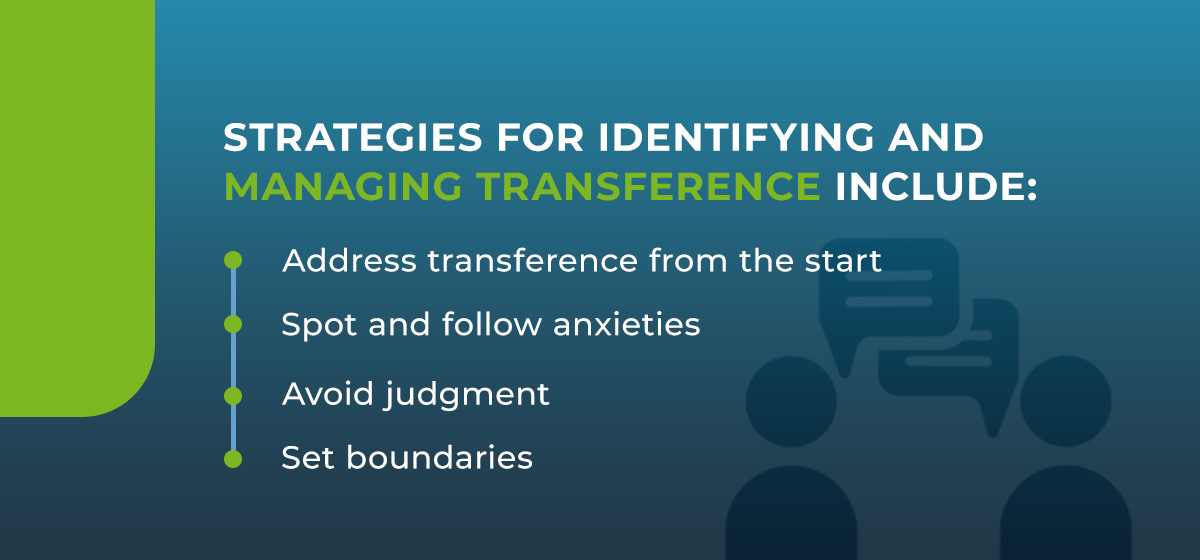
Therapist Self-Care: Managing Transference and Countertransference in Patient Care and Treatment
If you are a mental health professional, you understand just how nuanced the dynamics between yourself and your clients can be. It's common for a patient's feelings to redirect onto the therapist or for a therapist's feelings toward a patient to impact therapy — known as transference and countertransference, respectively. Both can provide useful insights into the inner world of the patient and mental health professional.
As a therapist, it's important to learn to differentiate your own feelings and those projected by the patient in order to provide effective care. You can manage transference and countertransference by maintaining professional boundaries, seeking supervision or consultation and reflecting on your reactions to ensure they don't interfere with your patient's progress.
Continue reading to learn how to spot the signs of transference and countertransference in therapy to provide the best possible care to patients.
The Importance of Understanding Transference in the Therapist-Patient Relationship
Therapy is a unique journey where you explore the human psyche and discuss emotions and feelings. It comes as no surprise that emotions can be mirrored between therapist and client. While a part of the process, it's critical to take steps to manage transference in order to provide effective care and see your clients make meaningful progress in therapy.
Defining Transference and Its Impact on Therapy

Transference in therapy refers to when a client projects their feelings about someone else onto their therapist. Emotions can be both positive and negative and may stem from an unresolved issue. For example, a patient who lost a parent as a child may look to the therapist for acceptance and unconditional love. While the therapist cares for their patient, it might not feel like enough to the patient, which can lead to misunderstandings, hurt, disappointment and even anger.
Transference plays a significant role in therapy by providing insights into a patient's inner world. When a patient transfers feelings from their past onto the therapist, it can reveal deeper issues and unresolved conflicts. Being able to identify transference allows both the client and therapist to delve deeper into underlying problems and address them together.
FREE DOWNLOAD: This checklist aids clinicians in identifying and assessing transference and countertransference.

How to Deal With Transference as a Therapist
While transference can reveal insights about a client's psyche, you must effectively manage it to avoid distorting the patient-therapist relationship or causing misunderstandings. The key lies in recognizing and harnessing its potential benefits while minimizing any negative impacts on the therapeutic journey.

Strategies for identifying and managing transference in therapy include:
- Address transference from the start: To prevent misunderstandings and provide the best possible care for your client, address any transference patterns openly with your client from the start. Bringing awareness to them can help avoid a distorted dynamic and facilitate a stronger therapeutic alliance with your patient.
- Spot and follow anxieties: You can manage transference by following any anxieties your client is displaying and using them to promote healing and growth. For example, if your client projects anxieties about a parental figure onto you, you might delve deeper into the wishes beneath those anxieties to facilitate healing.
- Avoid judgment: While some clients may appreciate learning how their patterns might be playing out in therapy, others may feel exposed or judged. Since transference often stems from past trauma, it's crucial to be gentle and non-judgmental when bringing up transference in your sessions, addressing it in a sensitive way that promotes healing.
- Set boundaries: While it's critical to acknowledge and manage transference, doing so should not compromise the boundaries that protect your client's well-being. Set and maintain clear, professional boundaries and discuss any boundary issues with supervisors or colleagues if you're unsure how to proceed.
Countertransference: Navigating Therapist's Reactions in Clinical Practice
Countertransference occurs when a therapist responds complementary to their patient's transference based on their own assumptions or dysfunctional beliefs. Like transference, countertransference can provide a critical source of information about the inner world of the patient and therapist. However, unaddressed countertransference can lead to biased judgments and compromised treatment decisions, hindering the therapeutic process.
Learning to recognize, understand, label and express your feelings about your sessions can help you use countertransference to provide effective care for your patients.
Recognizing Signs of Countertransference
Countertransference manifests as thoughts, feelings, emotions and attitudes a patient evokes in the therapist. It is a response to the patient that arises as a response to transference or from one's unresolved conflicts. Some examples of countertransference can have more adverse effects on the therapeutic process than others. Warning signs of countertransference a therapist can display include:
- Inappropriately disclosing personal information
- Not having boundaries
- Offering advice
- Wanting to “save” a client from their problems
- Being overly critical of the client
- Being overly supportive of the client
- Expressing attraction to clients
- Pushing clients to take action before they are ready
- Allowing personal experiences or feelings to get in the way of therapy
An example of countertransference is when a therapist thinks their patient has a similar personality to someone from their personal life, and in response to this belief, they treat the patient like the person they know. Unrecognized countertransference can have adverse effects on therapy outcomes, leading to bias and compromised treatment decisions.
For example, a therapist who transfers their feelings about relationships onto a client may have an adverse reaction when the client discusses their significant other. This reaction could cause the client to make a decision about the relationship partially based on the therapist's feelings rather than an objective analysis of the situation.
Effective Management of Countertransference
While often seen as an obstacle to be eliminated, countertransference is present in every therapeutic relationship. Additionally, your reactions to your patient can often provide valuable insight into the reactions the patient might elicit in people around them. However, it's important that you distinguish your countertransference from the patient's transference about unresolved problems. You can often do this through self-acknowledgment and minimizing your “blind spots.”
Self-reflection is integral to your role as a therapist, and, as such, it's best not to underestimate your reactions to your patients but rather address and deal with them in an honest way. Strategies to gain self-awareness and manage countertransference include:
- Mindfulness: As a therapist, you are subjected to your own feeling states during sessions, both emotional and physical. The more feelings you can tolerate from yourself, the more you can contain and hold your patients' unacceptable feelings. This means letting yourself feel anger, jealousy, love, sadness and other feelings that might occur in a session. If you can allow yourself to experience and accept your feelings, you will become a more present therapist and gain tools to provide better care to your patients.
- Guided imagery: Guided imagery can help therapists gain emotion regulation and manage countertransference. This involves imagery rescripting, or addressing specific memories of past experiences associated with present problems. In the technique, a supervisor may ask you to recall an aversive experience and to rescript an imagined change in the memory of that experience. For example, a childhood memory of being bullied or rejected might be modified by imagining an older peer entering the situation and inviting the person to play.
- Role-playing: In role-playing, a supervisor might ask you to describe a specific therapy situation where you felt powerful positive or negative emotions. You then become the patient as the supervisor plays the behaviors you described, allowing you to assess how you feel and what you learned as the patient. From there, you change roles so you can understand the situation from both sides. Your supervisor will then ask you about situations where similar emotions were experienced, with whom it happened and what you felt toward that person. This allows you to come up with a way to address countertransference and replay the situations in new ways that would be beneficial in real sessions with a patient.
When handled appropriately, countertransference can help you gain insight into your reactions and understand your patient's experiences. Through supervision, self-reflection and consultation, you can use your emotional responses to enhance empathy, improve communication and strengthen the therapeutic relationship. Ultimately, the key involves being aware of your countertransference reactions, reflecting on them consciously and using them to inform your clinical work positively.
Note that if you are having trouble managing countertransference and have taken steps to mitigate it already, always put the patient first. If you feel like they could benefit, you might refer your client out to a provider who is better prepared to engage with them.
Self-Care Strategies for Therapists
Self-care is crucial in your role as a mental health professional. Several self-care strategies can put you in a better mindset to work with clients, help you avoid burnout and manage countertransference more effectively.
Importance of Self-Care in Preventing Professional Burnout
There is a strong link between therapist well-being and effective patient care. Countertransference can easily occur when you are stressed or have a lot going on in your personal life, as can burnout — which can impact treatment outcomes. Signs of burnout can include mental or emotional exhaustion, cynicism about work and reduced feelings of personal accomplishment.
Practicing self-care can help you:
- Prevent burnout
- Avoid compassion fatigue
- Foster healthy boundaries
- Enhance professional effectiveness
- Improve mental health outcomes in patients
- Promote personal growth and development
Practical Self-Care Techniques for Therapists
It's important to care for yourself so you can stay present for your clients and protect your well-being. Self-care strategies you might implement into your daily routine include:
- Boundaries: Self-care can look like setting up personal and professional boundaries, which involves learning to say no and not feeling bad about it and being able to recognize your limitations and capacity within professional relationships. This can help protect your time, energy and mental state in a taxing profession.
- Regular breaks: Scheduling breaks is crucial, regardless of how busy you are most days. Set aside time throughout the day to step away from work and other responsibilities. During this time, practice mindfulness, stretch, do yoga or take a quick walk to get some fresh air. This can help you recharge your mental batteries so you're prepared to take on your next challenge.
- Take care of your physical health: It can be easy to forget about our physical health with busy schedules and other responsibilities weighing us down. Prioritize your health by working out, eating well and getting enough sleep. Regular exercise has been shown to reduce stress and boost well-being.
- Nurture your relationships: Spending time with loved ones and those you care about can help you get through particularly taxing days at work. Social connections can provide valuable emotional support in tough times.
- Check-in with yourself: Part of caring for yourself means regularly checking in with what you're feeling emotionally, mentally and physically. When you become more mindful of your feelings, you can address issues before they escalate. You should also be kind to yourself when you notice countertransference. Be proud of yourself for noticing your feelings and taking steps to care for yourself and your patient.
Enhancing Patient Care Through Therapeutic Boundaries

Boundaries act as the guideline for all involved in the therapeutic relationship, helping you ensure a successful relationship between yourself and your clients.
Here's how to set physical, material, time, emotional and intellectual or spiritual boundaries:
- Physical: Physical boundaries include how your patients reach you, whether that's in your office, virtually or through a phone call. Consider whether you're comfortable providing your personal cell phone number to patients or if you'd rather have a secure and separate phone specifically for work. Just be sure you are upfront with your patient in communicating what you are most comfortable with.
- Material: This relates to the financial side of running your practice and ensuring your financial health is stable enough to provide emotional support. Consider whether you want to offer alternative payment options to make therapy more affordable to patients or for those who don't have health insurance. Get comfortable setting boundaries by discussing payment issues with patients, such as missed payments.
- Time: Time boundaries include knowing when it's time to go home, wrap up therapy sessions or prepare cancellation policies. You can create time boundaries in your work by deciding how many hours you are able to work each day, setting reliable schedules for yourself and clients, creating a dependable cancellation policy and ending sessions on time, gently.
- Emotional: It's critical that you have a network of support, such as local resources for patients and consistent coping mechanisms for yourself to avoid taking on your patients' burdens as your own. Regularly take care of your emotional well-being and connect patients with local resources for help when you are away from work.
- Intellectual or spiritual: You must also create space for compassion in situations where opinions differ. Knowing what ideas guide your practice can help you prepare your patients for what to expect, whether you integrate religions or spiritual ideologies in your work. Remember to clear boundaries in cases where beliefs and ideas differ. The goal is to create a safe space where patients can share their thoughts despite personal beliefs.
Clear professional boundaries create safety for both patients and physicians. As the therapist, you are responsible for preserving these boundaries. If a minor violation occurs, it's best to transfer the patient out before it can become more problematic. By balancing empathy and professionalism and preserving boundaries, you can build a safe and effective therapeutic environment.
Explore ICANotes to Help Maintain Ethical Standards and Enhance Patient Care
Understanding examples of transference and countertransference and how they manifest in sessions can help you harness their benefits and provide effective care to clients.
It's also critical to practice self-care as a therapist and set boundaries regarding your time and energy. ICANotes is an electronic charting solution designed specifically for mental health care. Our software can help you save time on notetaking so you can focus on delivering quality care to clients. You can also use our software to identify and track transference and countertransference to help maintain ethical standards and enhance patient care.
Contact us today to request a free trial or to schedule a live demonstration.
Reviewed By

Lindsay Rutter
MA, NCC, LPC
Lindsay Rutter, MA, NCC, LPC, is a Licensed Professional Counselor with a Master’s Degree in Clinical Counseling. She has nearly 15 years of clinical and supervisory experience with extensive knowledge of mental health diagnoses, their etiology, and evidence-based treatments. Lindsay is the Clinical Director of a non-profit community mental health center and the owner of a private practice in Chester County, PA.

